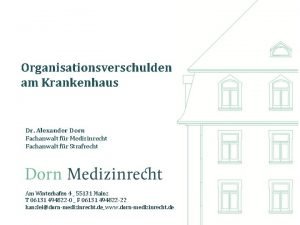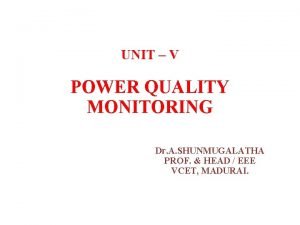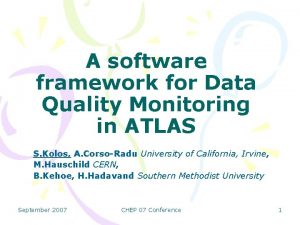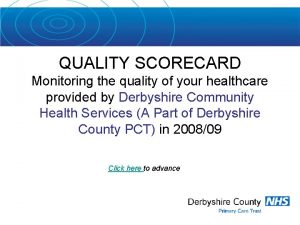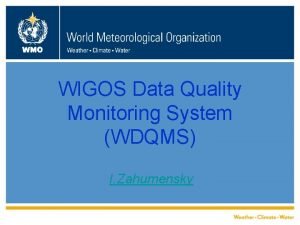Monitoring Processes Jrgen Dorn Motivation Monitoring Processes quality




















- Slides: 20

Monitoring Processes Jürgen Dorn

Motivation Monitoring Processes • quality today most important criteria on market • many organizations demand quality management from their suppliers • quality management (e. g. ISO 9000) demands continuous improvement of business processes • advantage for customer • advantage for provider • service level agreements (e. g. stock level for maintenance parts) • provider checks satisfaction otherwise penalty • customer will check too

Continuous Improvement • what does improvement mean? • improving quality of output from customer view point • quality by RATER dimensions • Reliability, • Assurance, • Tangibles, • Empathy, • Responsibility • better price • improving efficiency of used resources • no rework • no scrap producing • avoiding unnecessary coordination • fast completion • cost reduction Monitoring Processes

Business Process Analysis Monitoring Processes

Definition Monitoring Processes • business process monitoring enables an organization to measure and analyze process performance to identify critical process problems pro-actively, using data to make decisions that will improve the speed, quality and efficiency of business processes

KPI Monitoring Processes • Key Performance Indicator operationalization of critical success factors for whole enterprise (costs, revenue, customer satisfaction, . . . ) derive • Key Process Indicators for processes

Approaches to Monitoring • quantitative analysis of process • • simulating a process and measuring in simulation measuring at runtime measuring resource allocation cost analysis • qualitative analysis of process • quantitative analysis of output (service) • number of customers, services, income • qualitative analysis of output (service) • RATER questionnaire for quality Monitoring Processes

Measuring Time • in real time or in simulation • cycle time (end event – start event time) • average over many process instances • extreme durations • variance (goal reducing variance) • aggregation of duration of activities • bottlenecks • resource load in % (90% critical, 10% inefficient) • waiting times Monitoring Processes

Monitoring Processes Simple WFM Problem Management

Problem Management with Decision Monitoring Processes

Monitoring Processes Problem Management with Quality Evaluation

Activity-Based Costing (ABC) • Monitoring Processes

Measuring Quality with RATER Monitoring Processes • Reliability the ability to provide the service you have promised consistently, accurately, and in time • Assurance the knowledge, skills, and credibility of staff and their ability to use this expertise to inspire trust and confidence • Tangibles the physical evidence of the provided service this could be offices, equipment, employees, and the communication and marketing materials in use • Empathy the relationship between employees and customers • Responsiveness the ability to provide a quick, high quality service to customers

Process Benchmarking Monitoring Processes • comparing a business process with the process of the best competitor (e. g which parcel service has better delivery) • • which tasks are performed which technologies are applied which data and knowledge is applied which human resources • objectives (KPIs) of the processes should match • also benchmark with process from different sector possible • problems • not whole process may be disclosed • process may be whitewashed

Service Level Agreements • a performance-based technique where a written agreement (contract) is established between customer and service provider defining • key service objectives, • metrics, • acceptable quality levels, and • compensation Monitoring Processes

Example • problem management • levels • gold, silver and bronze customer • gold: • answer in 6 hours • 6 solutions / month • answer by top expert • silver: • answer in 24 hours • 4 solutions / month • if no answer found by team delivery to expert • bronze: • automatic answers • 3 solutions Monitoring Processes

Service Quality Attributes / Metrics Monitoring Processes • reliability (correct operation) • availability (time when service is available) • usability (user experience) • security (confidentiality, authenticity, integrity) • performance (response time, throughput, timeliness) • auditability (storing records for financial or legal audits) • in principle, all attributes known from service quality, but some are difficult to be measured (e. g. empathy)

Monitoring Processes Business-driven IT Management (BDIM) • IT Service Management • measurement and optimization of IT resources in organization • IT resources are used for different business processes • solution: service level agreements between business and IT management • better solution in IT management would be to also consider business KPIs 18

Monitoring Processes Business-driven IT Management (BDIM) • IT Service Management is an independent unit in many organizations or outsourced • Business Processes are supported by IT • KPI/SLA on Business Process layer may be fast completion of customer order • IT Services are governed by SLAs negotiated between units (e. g. availability of CPU or storage capacity) • IT Management typically does not know the KPI of business • optimization independent of business processes (e. g. reduce active (virtual) server or used cloud resources) • BDIM tries to negotiate between business and IT

Conclusions Monitoring Processes • measuring and monitoring is necessary in processes • continuous improvement • service level agreements • setting goals what shall be achieved in defined period • improvements are achievable by • • • new technology less media breaks in process (no mapping of data) parallelism automation of tasks application of alternative resources exception handling
 Larson-miller parameter ppt
Larson-miller parameter ppt Dorn rune
Dorn rune Anne dorn-herkströter
Anne dorn-herkströter Alexander dorn rechtsanwalt
Alexander dorn rechtsanwalt Concurrent in os
Concurrent in os Old quality vs new quality
Old quality vs new quality Project quality management pmp
Project quality management pmp Quality control basics
Quality control basics Pmbok quality assurance vs quality control
Pmbok quality assurance vs quality control Quality management gurus
Quality management gurus Quality improvement vs quality assurance
Quality improvement vs quality assurance Quality is free
Quality is free Quality assurance vs quality control
Quality assurance vs quality control Quality improvement vs quality assurance
Quality improvement vs quality assurance Permanent power quality monitoring equipment
Permanent power quality monitoring equipment Dqmf
Dqmf Nwqmc conference
Nwqmc conference Quality monitoring scorecard
Quality monitoring scorecard Quality monitoring scorecard
Quality monitoring scorecard Wigos data quality monitoring system
Wigos data quality monitoring system National water quality monitoring conference
National water quality monitoring conference



